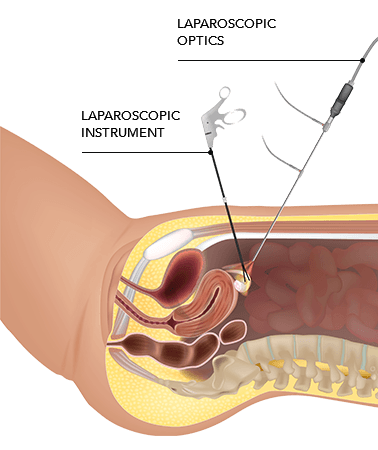Laparoscopy
What is a Laparoscopy?

A Laparoscopy is a surgical procedure that allows a doctor to examine the inside of the abdomen and pelvic area using a laparoscope, a long, thin, flexible instrument with a camera and light attached to it.
The laparoscope is inserted through small incisions in the abdominal wall, allowing the doctor to view the internal organs and structures without having to make a large incision. Laparoscopy is commonly used to diagnose and treat conditions such as infertility, endometriosis, pelvic pain, ovarian cysts, and ectopic pregnancy, among others. It can also be used to perform surgeries such as tubal ligation, ovarian cyst removal, and removal of uterine fibroids.
The procedure is usually performed under general or regional anesthesia.Laparoscopy is a minimally invasive technique performed under general anaesthesia, with intubation, using a laparoscope inserted through the abdominal wall.Available appointments for laparoscopy are usually within 4-8 weeks. Procedures are not performed during menstruation cycle, however spotting is not a problem. Optimal timing can be achieved with single-phase hormonal contraception without omission (e.g. Marvelon) or gestagen preparation (e.g. Provera tablets).Once you are under general anaesthesia, the abdominal cavity is filled with gas (CO2).
Subsequently, a laparoscope (an optical device allowing the small pelvis and abdominal cavity to be overlooked) is inserted through the abdominal wall. Laparoscopy is one of the so-called minimally invasive techniques that are preferred today. The postoperative course is significantly better tolerated after these techniques and the recovery time is also significantly shorter. The whole surgical procedure takes about 20 – 60 minutes.According to the range of performance and difficulty, we distinguish between surgical and diagnostic laparoscopy.
- DIAGNOSTIC LAPAROSCOPY
Diagnostic laparoscopy is performed to simply inspect the organs of the small pelvis (uterus, ovaries, fallopian tubes). It is performed to detect findings in the abdominal cavity (adhesions, cysts, developmental defects of the uterus, chronic pain, etc.). - OPERATIONAL LAPAROSCOPY It allows the removal of findings discovered during diagnostic laparoscopy or detected by ultrasound. If laparoscopic surgery is planned (e.g. in case of operation on the ovary, removal of the cyst, disruption of adhesions), it is necessary to make another 2-3 small skin incisions to introduce other surgical instruments into the abdominal cavity.
- WHEN IS LAPAROSCOPY PERFORMED?
If an ovarian cyst or ovarian pathology is found In the diagnosis and treatment of fibroids When examining an abnormal ultrasound finding For chronic lower abdominal pain In case of infertility – tests of patency of the fallopian tubes In ectopic pregnancy When checking after procedures on the uterus For laparoscopic sterilisation – i.e. permanent prevention of conception
TYPES OF LAPAROSCOPIC PROCEDURES:
- laparoscopic adnexectomy = removal of one or both ovaries
- laparoscopic cystectomy, cyst extirpation = removal of the cyst from the ovary (the ovary remains)
- laparoscopic sterilization = irreversible interruption / removal of the fallopian tubes and prevention of fertility, it is not possible to conceive spontaneously after the procedure. The ovary and its hormonal function are preserved, including menstruation.
- laparoscopic adhesionolysis = loosening, disruption of adhesions in the abdominal cavity
- laparoscopic salpingectomy = removal of one or both fallopian tubes (eg in ectopic pregnancy)
